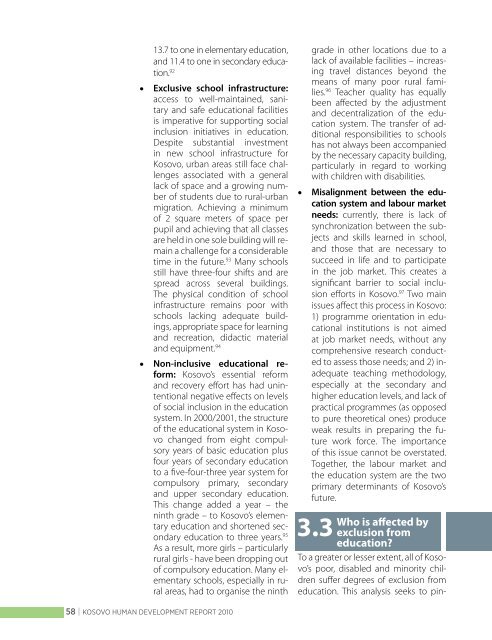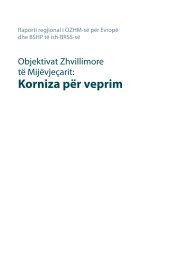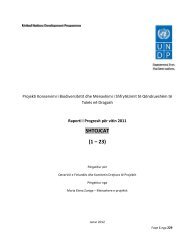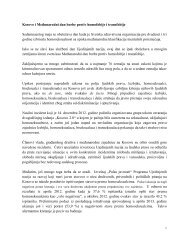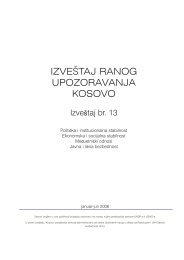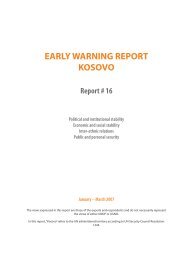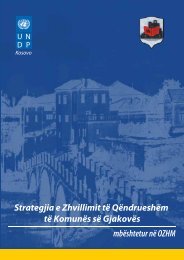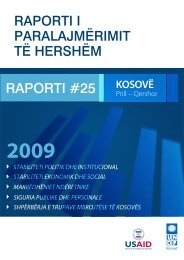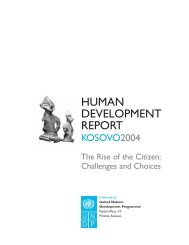Kosovo Human Development Report 2010 - UNDP Kosovo - United ...
Kosovo Human Development Report 2010 - UNDP Kosovo - United ...
Kosovo Human Development Report 2010 - UNDP Kosovo - United ...
Create successful ePaper yourself
Turn your PDF publications into a flip-book with our unique Google optimized e-Paper software.
13.7 to one in elementary education,<br />
and 11.4 to one in secondary education.<br />
92<br />
• Exclusive school infrastructure:<br />
access to well-maintained, sanitary<br />
and safe educational facilities<br />
is imperative for supporting social<br />
inclusion initiatives in education.<br />
Despite substantial investment<br />
in new school infrastructure for<br />
<strong>Kosovo</strong>, urban areas still face challenges<br />
associated with a general<br />
lack of space and a growing number<br />
of students due to rural-urban<br />
migration. Achieving a minimum<br />
of 2 square meters of space per<br />
pupil and achieving that all classes<br />
are held in one sole building will remain<br />
a challenge for a considerable<br />
time in the future. 93 Many schools<br />
still have three-four shifts and are<br />
spread across several buildings.<br />
The physical condition of school<br />
infrastructure remains poor with<br />
schools lacking adequate buildings,<br />
appropriate space for learning<br />
and recreation, didactic material<br />
and equipment. 94<br />
• Non-inclusive educational reform:<br />
<strong>Kosovo</strong>’s essential reform<br />
and recovery effort has had unintentional<br />
negative effects on levels<br />
of social inclusion in the education<br />
system. In 2000/2001, the structure<br />
of the educational system in <strong>Kosovo</strong><br />
changed from eight compulsory<br />
years of basic education plus<br />
four years of secondary education<br />
to a five-four-three year system for<br />
compulsory primary, secondary<br />
and upper secondary education.<br />
This change added a year – the<br />
ninth grade – to <strong>Kosovo</strong>’s elementary<br />
education and shortened secondary<br />
education to three years. 95<br />
As a result, more girls – particularly<br />
rural girls - have been dropping out<br />
of compulsory education. Many elementary<br />
schools, especially in rural<br />
areas, had to organise the ninth<br />
58 | KOSOVO HUMAN DEVELOPMENT REPORT <strong>2010</strong><br />
grade in other locations due to a<br />
lack of available facilities – increasing<br />
travel distances beyond the<br />
means of many poor rural families.<br />
96 Teacher quality has equally<br />
been affected by the adjustment<br />
and decentralization of the education<br />
system. The transfer of additional<br />
responsibilities to schools<br />
has not always been accompanied<br />
by the necessary capacity building,<br />
particularly in regard to working<br />
with children with disabilities.<br />
• Misalignment between the education<br />
system and labour market<br />
needs: currently, there is lack of<br />
synchronization between the subjects<br />
and skills learned in school,<br />
and those that are necessary to<br />
succeed in life and to participate<br />
in the job market. This creates a<br />
significant barrier to social inclusion<br />
efforts in <strong>Kosovo</strong>. 97 Two main<br />
issues affect this process in <strong>Kosovo</strong>:<br />
1) programme orientation in educational<br />
institutions is not aimed<br />
at job market needs, without any<br />
comprehensive research conducted<br />
to assess those needs; and 2) inadequate<br />
teaching methodology,<br />
especially at the secondary and<br />
higher education levels, and lack of<br />
practical programmes (as opposed<br />
to pure theoretical ones) produce<br />
weak results in preparing the future<br />
work force. The importance<br />
of this issue cannot be overstated.<br />
Together, the labour market and<br />
the education system are the two<br />
primary determinants of <strong>Kosovo</strong>’s<br />
future.<br />
3.3<br />
Who is affected by<br />
exclusion from<br />
education?<br />
To a greater or lesser extent, all of <strong>Kosovo</strong>’s<br />
poor, disabled and minority children<br />
suffer degrees of exclusion from<br />
education. This analysis seeks to pin-


